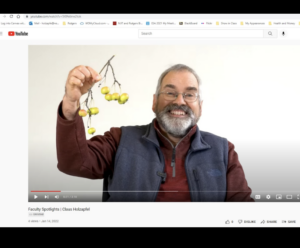Fusion Ecology: as an ecologist I am fascinated by the intriguing ways of how species interact with each other. Within that topic I address questions spanning community, population and evolutionary ecology of plants and animals. The list of keywords describing my past and present work is long: disturbance, breeding systems, diversity, invasion, seed ecology, root interactions, clonal plant biology, species interaction. So far I conducted field research in a wide range of systems ranging from Old World and New World deserts, through Mediterranean-type ecosystems to postindustrial ‘brown’ fields. Significant parts of my research take place also in the greenhouse and the lab: sometimes nature is simply too complex to pursue specific questions.
Community ecology – the main theme of my research – is the examination of ecological and evolutionary processes and their outcome in populations and communities. These processes can be detected at a variety of ecological and temporal scales; accordingly, my research includes studies of individuals, populations, communities and higher levels (flora).
I am pursuing two main goals: (1) to predict the ecological consequences and evolutionary trajectories of interactions between plants and animals. Ecological interactions are understood to have the potential to lead to intricate co-evolution among interacting species. I am interested to find out whether coexisting species are coevolved and affect each other in non-random ways. The leading question is whether communities are much more than simple chance assemblies. Perturbed systems – systems that are altered from their pristine state such as postindustrial sites – are ideal study objects to address such a question, since here coevolved interactions are likely altered and novel. Good examples are plant communities that are entered by non-native organisms or systems otherwise heavily impacted by human activity. Needless to say, such systems are increasingly common throughout the East Coast Region. (2) to detect the mechanisms by which organisms plants adapt to varying environments. Real environments are never constant and organisms are likely to encounter new abiotic factors and/or new neighbors. Evolutionary and ecological plant responses to stochastic environments often differ strongly from responses to predictable environmental change.

PUBLICATIONS (selection, click on titles for links)
Moloney K.A., Fuentes-Ramirez A., Holzapfel C. (2021). Climate impacts on fire risk in desert shrublands: a modeling study. Frontiers in Ecology Biogeography and Macroecology – Fire Regimes in Desert Ecosystems: Drivers, Impacts and Changes, doi: 10.3389/fevo.2021.601877
Cullen, A.C., Farley K.E., Pagano S.S., Gallagher, F.J., Holzapfel C. (2020). All in the timing: potential avian seed dispersal pathways of two invasive Viburnum species. Plant Ecology 221: 951–963.
Salisbury, A., Gallagher F., Parag, H.A., Meneses-Florián, L., Holzapfel C. (2020). Plant diversity continues to increase in an urban wildland after 4 decades of unaided brownfield vegetation development. Urban Ecosystems 24: 95-111
Moloney K.A., Mudrak E., Fuentes-Ramirez A., Parag H., Schat M., Holzapfel C. (2019). Increased fire risk in Mojave and Sonoran shrublands due to exotic species and extreme rainfall events. Ecosphere. https://doi.org/10.1002/ecs2.2592
Tian L., Zhang Y., Holzapfel C., Huang K., Chen N., Tao J., Zhu J. (2018). Vegetation pattern in Northern Tibet in relation to environmental and geo-spatial factors. Journal of Resources and Ecology 9 (5): 526-537
Gallagher F., Goodey N.M. , Hagmann D., Singh J.P., Holzapfel C., Litwhiler M., Adams Krumins J. (2018) Urban re-greening: a case study in multi-trophic biodiversity and ecosystem functioning in a post-industrial landscape. Diversity 10(4): 119
Brusa, A., Holzapfel, C. (2018). Population structure of Ailanthus altissima in northern New Jersey: the role of land-use history and management. Journal of the Torrey Botanical Society 145:55-68.
Wadhwa S., Gallagher F.J., Rodriguez-Saona C., Holzapfel C. (2017). Exposure to heavy metal stress does not increase fluctuating asymmetry in populations of isopod and hardwood trees. Ecological Indicators 76: 42-51.
Fuentes-Ramirez A., Veldman J.W., Holzapfel C., Moloney K.A. (2016). Spreaders, igniters and burning shrubs: plant flammability explains novel fire dynamics in grass-invaded deserts. J. Appl. Ecol. 26:2311-2322.
Fuentes-Ramirez A., Schafer, J.L., Mudrak E., Schat M., Parag H.A. , Holzapfel C., Moloney K. (2015). Spatio-temporal impacts of fire on soil nutrient availability in Larrea tridentata shrublands of the Mojave Desert, USA. Geoderma 259-260: 126-133.
Fuentes-Ramirez A., Mudrak E., Caragea P., Holzapfel C. & Moloney K. (2015). Assessing the impact of fire on the spatial distribution of Larrea tridentata in the Sonoran Desert, USA. Oecologia. DOI: 10.1007/s00442-014-3214-1
Tielbörger K. Bilton M.C., Metz J. , Kigel J., Holzapfel C., Lebrija-Trejos E., Konsens I., Parag H., Sternberg M. (2014). Middle-Eastern plant communities tolerate nine years of drought in a multi-site climate manipulation experiment. Nature Communications, DOI: 10.1038/ncomms6102 .
Mudrak, E. L., Schafer, J.L., Fuentes-Ramirez, A., Holzapfel, C., Moloney, K. A. (2014). Predictive modeling of spatial patterns of soil nutrients related to fertility islands. Landscape Ecology 29: 491-505.
June-Wells, M.R., Gallagher, F.J., Holzapfel, C. (2014). Evaluating population border dynamics among Artemisia vulgaris and community constituents in an urban successional plant assemblage. Journal of the Torrey Botanical Society 141: 14-28.
Zhang, Y., Holzapfel, C., Yuan, X. (2013). Scale dependent ecosystem service. In: Wratten,S. Sandhu, H. Cullen, R. and Costanza R. (Eds.), Ecosystem Services in Agricultural and Urban Landscapes. p.107-121. Wiley-Blackwell,Oxford.
Schafer, J.L., Mudrak, E.L., Haines, C.E., Parag, H.A., Moloney, M.A., Holzapfel, C. (2012). The association of native and non-native annual plants with Larrea tridentata (creosote bush) in the Mojave and Sonoran Deserts. Journal of Arid Environments 87: 129-135.
Gallagher F.J., Pechmann I., Holzapfel C., Grabosky J. (2011). Altered vegetative assemblage trajectories within an urban brownfield. Environmental Pollution 159: 1159-1166.
Harel D., Holzapfel C., Sternberg M. (2011). Seed mass and dormancy of annual plant populations and communities decreases with aridity and rainfall predictability. Basic and Applied Ecology 12: 674-684.
Sternberg, M., Holzapfel, C., Tielbörger, K. Sarah, P., Kigel, J., Lavee, H., Fleischer, A., Jeltsch, F.& Köchy, M. (2011). The use and misuse of climatic gradients for evaluating climate impact on dryland ecosystems – an example for the solution of conceptual problems. In: J. Blanco & H. Kheradmand (Eds.), Climate Change – Geophysical Foundations and Ecological Effects, pp. 361-374.
Gallagher, F.J., Pechman, I., Holzapfel, C., Grabosky, J. (2011). Altered vegetative assemblage trajectories within an urban brownfield. Environmental Pollution 159:1159-66.
Holzapfel, C., Shahrokh, P., Kafkewitz, D. (2010). Polyphenol oxidase activity in the roots of Seedlings of Bromus and other grass genera. American Journal of Botany 97: 1-5.
Hofer C., Gallagher F.J., Holzapfel C. (2010). Metal accumulation and performance of nestlings of passerine bird species at an urban brownfield site. Environmental Pollution 158: 1207–1213.
Holzapfel C., Parag H.A., Shmida A. (2009). Resilience of Mediterranean and desert vegetation after disturbance. Forstarchiv 90:297-304.
Moloney, K.A., Holzapfel, C., Tielbörger, K., Jeltsch, F., Schurr, F. (2009) Rethinking the common garden in invasion research. Perspectives in Plant Ecology, Evolution and Systematics 11:311-320.
Cincotta, C., Adams, J.M., Holzapfel, C. (2009): Testing the enemy release hypothesis: A comparison of foliar insect herbivory of the exotic Norway maple (Acer platanoides L.) and the native sugar maple (A. saccharum L.). Biological Invasions Biological Invasions 11:2, 379-388.
Holzapfel, C. (2008) Deserts. In S.E. Jørgensen & B.D. Fath (eds.), Vol.2 of Encyclopedia of Ecology, pp. 879-898. Oxford: Elsevier.
Sapir, Y., Mazer, S.J., & Holzapfel, C. (2008) Sex Ratio. In S.E. Jørgensen & B.D. Fath (Eds.),. Vol. 4 of Encyclopedia of Ecology, pp. 3243-3248. Oxford: Elsevier.
Holzapfel, C., Tielbörger, K., Parag, H.A., Kigel, J., and Sternberg, M. (2006). Annual plant-shrub interactions along an aridity gradient in Israel. Basic and Applied Ecology 7: 268-279.
Alpert, P., Holzapfel, C., & Slominski, C. (2003). Differences in performance between genotypes with different degrees of resource sharing in Fragaria chiloensis. Journal of Ecology 91: 27-35.
Schenk, H.J., Holzapfel, C., Hamilton, J.G., & Mahal, B.E. (2003): Spatial ecology of a small desert shrub on adjacent geological substrates. Journal of Ecology 91: 383-395.
Holzapfel, C. & Alpert, P. (2003): Root cooperation between plants of the same clone. Oecologia 134: 72-77.
Alpert, P., Bone, E., & Holzapfel, C. (2000): Invasiveness and invasibility: the possible role of environmental stress in preventing biological invasions by plants. Perspectives in Plant Ecology, Evolution and Systematics 3: 52-66
Hamilton, J.G., Holzapfel, C., & Mahall, B.E. (1999): Coexistence and interference between a native perennial grass and non-native annual grasses in California. Oecologia 121: 518- 526.
Holzapfel, C. & Mahall, B.E. (1999): Bidirectional facilitation and interference between shrubs and annuals in the Mojave Desert. Ecology 80: 1747-1761.
